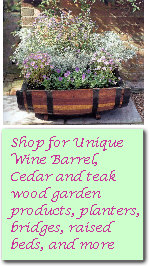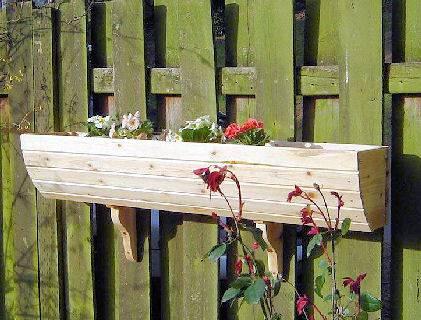| Common Name
Botanical Name |
Height Width |
Ornamental Features |
Bloom Season |
Comment |
| Ornamental Kale
(Brassica oleracea) |
1 foot tall and wide |
Green and white, pink, red or
purple foliage. |
Foliage color in winter |
Plant in fall for color after
frost. |
| Ornamental Pepper
(Capsicum annuum) |
1 to 2˝ feet tall and wide |
Fruit range in color from
yellow to orange or red and purple to near black. |
Midsummer to frost |
The fruit of ornamental
peppers are edible but extremely hot. |
| Annual Vinca
(Catharanthus roseus) |
6 to 24 inches tall |
White, pink, rose, lavender,
purple, red or salmon. |
Early summer to frost |
Very heat and drought
tolerant. |
| Coleus
(Solenostemon scutellarioides) |
1 to 3 feet tall and wide |
Colorful foliage often with
lobed or cut margins. |
Remove flowers for best
foliage |
Select sun-tolerant cultivars.
|
| Creeping Zinnia
(Sanvitalia procumbens) |
6 inches tall and at least 2
feet wide |
Tiny, golden, daisylike
flowers. |
Summer to frost |
Not suited for coastal
climate. Great in hot, dry areas. |
| Cypress Vine
(Ipomoea quamoclit) |
Climbs or trails up to 10
feet. |
Tiny brilliant red flowers
above delicate fern-like foliage. |
Summer to frost |
Very tough despite delicate
appearance. |
| Dusty Miller
(Senecio cineraria) |
6 to 12 inches tall and wide |
Soft, finely cut
whitish-silver leaves. |
Foliage color from spring
until frost |
Excellent foliage contrast. |
| Wallflower
(Erysimum or Cheiranthus species) |
6 to 24 inches tall and wide |
Cream, yellow, orange, purple
and maroon. |
Spring to early summer |
Plant in the fall for spring
flowering. |
| French Marigold
(Tagetes patula) |
6 to 18 inches tall and wide |
Yellow, gold, orange and
mahogany red. |
Late spring to frost |
Remove spent flowers for
continued bloom. |
| Gazania
(Gazania rigens) |
6 to 12 inches tall and wide |
Daisy-like yellow, orange,
pink or red flowers. |
All summer |
Good choice for hot, dry
locations. |
| Geranium
(Pelargonium x hortorum) |
12 to 36 inches tall and wide |
White to pink, salmon or red
flowers. Many cultivars have variegated leaves. |
All summer |
Remove spent flowers for
continued bloom. |
| Heliotrope
(Heliotropum arborescens) |
12 to 36 inches tall and wide |
Scented purple or lavender
blooms in clusters. |
All summer |
The species is more sweetly
scented and larger than modern cultivars. |
| Ivy-Leafed Geranium
(Pelargonium peltatum) |
1 foot tall by 3 to 4 feet
wide |
Colors range from white to
pink, salmon and red.
Branches trail like vines. |
All summer |
Best with some afternoon
shade. |
| Sweet Pea
(Lathyrus odoratus) |
Vines up to 6 feet, bush types
1 to 2 feet tall |
Fragrant, colorful flowers.
Bush types are suitable for window boxes. |
Spring |
Sweet Peas grow best under
cool conditions. Plant in late winter for early spring bloom. Plant at
Christmas on the coast. |
| Licorice Plant
(Helichrysum petiolare) |
6 to 12 inches tall, 3 to 4
feet wide |
Trailing plant with fuzzy
round leaves that are silver gray, variegated or lime green. |
Foliage color all summer |
Used as contrasting foliage.
Very tolerant of hot, dry weather. |
| Sweet Alyssum
(Lobularia maritima) |
4 to 8 inches tall by 1 foot
wide |
Honey-scented flowers are
white, pink, rose or purple. |
Late spring until frost |
Alyssum may decline in
midsummer. Shear, feed and water to rejuvenate. |
| Lotus Vine
(Lotus berthelotii) |
6 to 8 inches tall by 3 to 4
feet wide |
Feathery foliage on gray
trailing vines followed by bright red flowers |
Late summer |
Likes hot, dry weather. |
| Petunia
(Petunia hybrida) |
4 to 12 inches tall by 24 to
48 inches wide |
Virtually all colors are
available. |
All summer |
Require ample moisture and
fertility to thrive. Trailing cultivars are excellent in baskets.
|
| Moss Rose
(Portulaca grandiflora) |
6 to 9 inches tall by 12 to 18
inches wide |
Wide variety of colors in
single and double flowers. |
All summer until frost |
Thrives in hot, dry locations.
New hybrid types stay open longer. |
| Fan Flower
(Scaveola aemula) |
6 inches tall by 4 feet wide |
Blue or white flowers on long
trailing branches. |
Prolific from spring until
frost |
Very heat and drought
tolerant. |
| Trailing Lantana
(Lantana montevidensis) |
6 to 12 inches tall by 3 to 4
feet wide |
Lavender or white flowers on
trailing stems. |
All summer |
Tolerates hot, dry windy
conditions. |
| Variegated Periwinkle
(Vinca major ‘Variegata’) |
6 inches tall by 3 to 4 feet
wide |
White-edged or lime-centered
green leaves on trailing stems. |
Blue flowers, spring; grown
for foliage |
Excellent foliage contrast.
|
| Verbena
(Verbena x hybrida) |
6 to 12 inches tall, 12 to 24
inches wide |
Red, purple, pink and white
flowers on bushy or spreading plants. |
Mid spring until frost |
Thrives in hot weather. |
| Botanical Name
Common Name |
Height Width |
Ornamental Features |
Bloom Season |
Comment |
| Pansy
(Viola x wittrockiana) |
6 to 8 inches tall and wide |
Available in nearly all colors
of the rainbow. |
Fall through spring |
Plant in the fall. Blooms
through winter. Peak bloom in spring. |
| Impatiens
(Impatiens wallerana) |
6 to 36 inches tall and wide |
Almost all colors except blue
are available. |
Continuous flowering from
spring until fall |
Keep constantly moist.
|
| Purple Shamrocks
(Oxalis purpurea) |
10 inches tall and wide |
Large purple leaves and white
or pink flowers. |
Spring |
Grown for its foliage. |
|
Tuberous begonia
(Begonia x tuberhybrida) |
12 to 18 inches tall and wide |
Large flowers in red, pink,
orange, yellow, white and in bicolors. |
Spring through summer |
Lift tubers in fall and store;
replant in spring. |
|
Caladium
(Caladium x hortulanum) |
12 to 30 inches tall and wide |
Arrow-shaped leaves patterned
in red, pink, white and green. |
Grown for colorful summer
foliage |
Keep evenly moist, fertilize
frequently. |
|
Coleus
(Solenostemon scutellarioides) |
1 to 3 feet tall and wide |
Leaf color mixtures include
magenta, red, copper, orange, yellow, chartreuse and green. |
Pinch off flower spikes |
Most cultivars grow best in
shade or part shade. |
| Polka Dot Plant
(Hypoestes phyllostachya) |
12 to 18 inches tall and wide |
Pink or white speckles on
green leaves. |
Grown for summer foliage |
Beautiful foliage with white
or pink flowers. Very tough. |
|
Fuchsia
(Fuchsia cultivars) |
2 to 3 foot wide trailing |
Drooping tear-shaped buds open
to flouncy interiors Flowers in red, pink, purple, coral, white and
combinations. |
Spring through summer |
![]() Gardeners' Corner
Kids'
Garden
Sustainable Garden
Contact Us
Gardeners' Corner
Kids'
Garden
Sustainable Garden
Contact Us![]()


